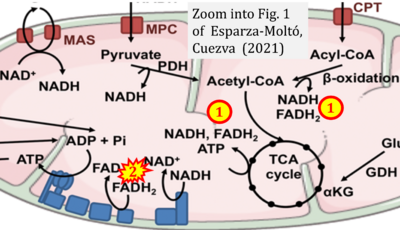Esparza-Molto 2020 Antioxid Redox Signal
| Esparza-Moltó PB, Cuezva JM (2020) Reprogramming oxidative phosphorylation in cancer: a role for RNA-binding proteins. Antioxid Redox Signal 33:927-45. https://doi.org/10.1089/ars.2019.7988 |
Esparza-Molto PB, Cuezva JM (2020) Antioxid Redox Signal
Abstract: Significance: Cancer is a major disease imposing high personal and economic burden draining large part of National Health Care and Research budgets worldwide. In the last decade, research in cancer has underscored the reprogramming of metabolism to an enhanced aerobic glycolysis as a major trait of the cancer phenotype with great potential for targeted therapy. Recent Advances: Mitochondria are essential organelles in metabolic reprogramming for controlling the production of biological energy through oxidative phosphorylation (OXPHOS) and the supply of metabolic precursors that sustain proliferation. In addition, mitochondria are critical hubs that integrate different signaling pathways that control cellular metabolism and cell fate. The mitochondrial ATP synthase plays a fundamental role in OXPHOS and cellular signaling. Critical Issues: This review overviews mitochondrial metabolism and OXPHOS, and the major changes reported in the expression and function of mitochondrial proteins of OXPHOS in oncogenesis and in cellular differentiation. We summarize the prominent role that RNA-binding proteins (RNABPs) play in the sorting and localized translation of nuclear-encoded mRNAs that help define the mitochondrial cell-type-specific phenotype. Moreover, we emphasize the mechanisms that contribute to restrain the activity and expression of the mitochondrial ATP synthase in carcinomas, and illustrate that the dysregulation of proteins that control energy metabolism correlates with patients' survival. Future Directions: Future research should elucidate the mechanisms and RNABPs that promote the specific alterations of the mitochondrial phenotype in carcinomas arising from different tissues with the final aim of developing new therapeutic strategies to treat cancer.
• Bioblast editor: Gnaiger E
Correction: FADH2 and Complex II
- FADH2 is shown as the substrate feeding electrons into Complex II (CII). This is wrong and requires correction - for details see Gnaiger (2024).
- Gnaiger E (2024) Complex II ambiguities ― FADH2 in the electron transfer system. J Biol Chem 300:105470. https://doi.org/10.1016/j.jbc.2023.105470 - »Bioblast link«
Labels: Pathology: Cancer


